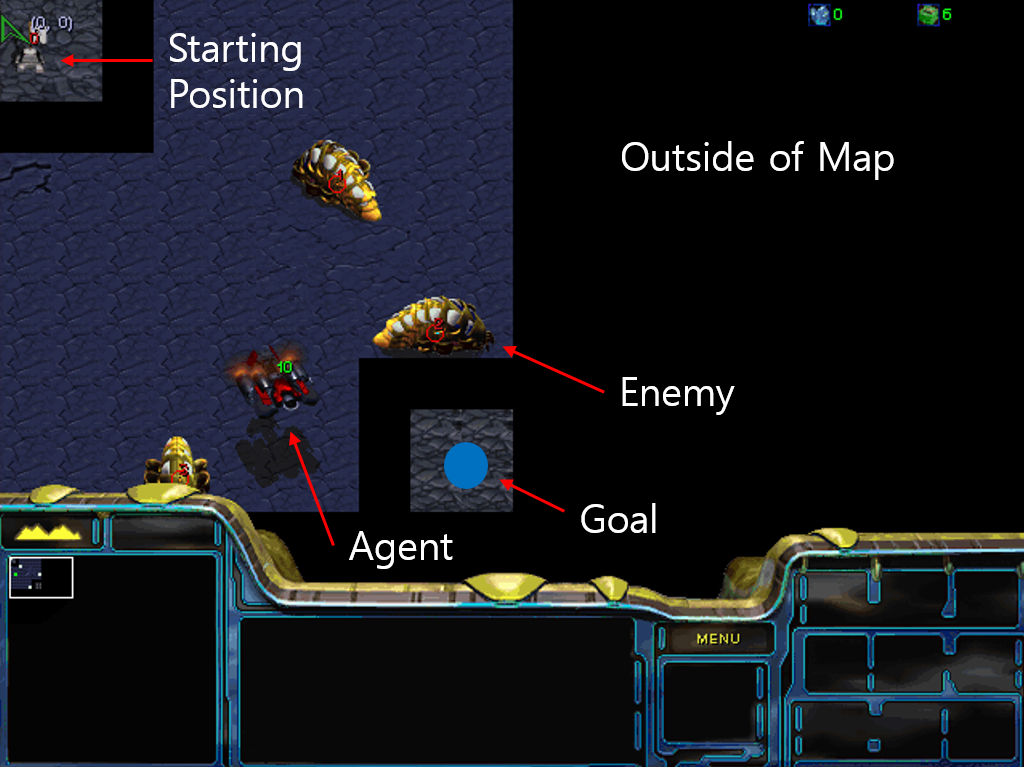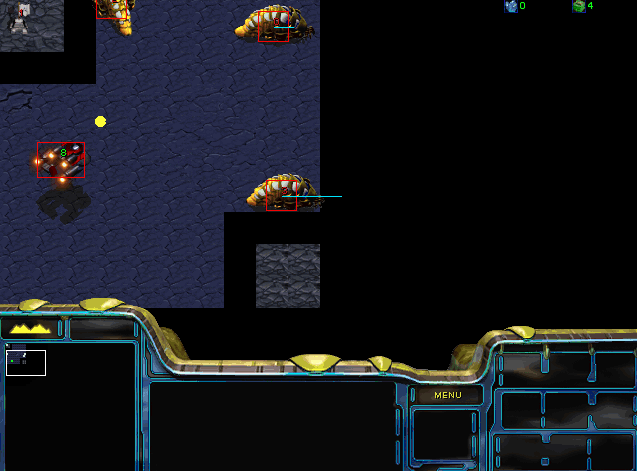SAIDA RL Tutorial
In this tutorial, we will show you how to develop an agent and model for reinforcement learning using SAIDA RL.
In order to help you understand, we will give you an easy example of AvoidReavers scenario using Deep SARSA algorithm.
Select a Scenario
SAIDA RL provides a few different types of scenario such as combat, avoidance, and survival. Choose one of these examples of from them. In this tutorial, we will describe AvoidReavers scenario as an example.

Define an Agent
The next thing to do is to define an agent. SAIDA RL has a flexible structure so you can apply various existing off the shelf RL agents(DQN with its variants, A2C, DDPG, PPO etc).
To define a new agent, you must inherit the parent class core.common.agent and implement each function.
Or you can use an algorithm that is already implemented.
From now on, we will demonstrate implementing Deep SARSA agent, one of the classical algorithms of RL.
from core.common.agent import Agent
from core.common.util import *
from collections import deque
import random
import numpy as np
# Inherit Agent class as a parent class
class DeepSARSAgent(Agent):
# Detailed description about input parameters see API Doc
def __init__(self, action_size, model, load_model=False, discount_factor=0.99, learning_rate=0.001,
epsilon=1, epsilon_decay=0.999, epsilon_min=0.01,
file_path='', training_mode=True, **kwargs):
# Call constructor of parent's class
super(DeepSARSAgent, self).__init__(**kwargs)
# Set parameters from inputs
self.load_model = load_model
self.action_size = action_size
self.model = model
self.discount_factor = discount_factor
self.learning_rate = learning_rate
self.epsilon = epsilon
self.epsilon_decay = epsilon_decay
self.epsilon_min = epsilon_min
self.training_mode = training_mode
self.file_path = file_path
# Set the epsilon as minimum value, if not training mode.
if not self.training_mode:
self.epsilon = self.epsilon_min
# memory for train (S,A,R,S',A')
self.observations = deque(maxlen=2)
self.recent_observation = None
self.recent_action = None
if self.load_model and os.path.isfile(file_path):
self.load_weights(file_path)
# Get an action to be taken from observation
def forward(self, observation):
# Take a random acton with probability = epsilon
if self.training_mode and np.random.rand() <= self.epsilon:
action = random.randrange(self.action_size)
else:
# Take a best acton with probability = (1 - epsilon)
state = np.float32(observation)
q_values = self.model.predict(np.expand_dims(state, 0))
action = np.argmax(q_values[0])
# set memory for training
self.recent_observation = observation
self.recent_action = action
return [action]
# Updates the agent's network
def backward(self, reward, terminal):
self.observations.append([self.recent_observation, self.recent_action, reward, terminal])
if self.step == 0:
return
# Decaying the epsilon
if self.epsilon > self.epsilon_min:
self.epsilon *= self.epsilon_decay
# Use a memory to train
experience = self.observations.popleft()
state = np.float32(experience[0])
action = experience[1]
reward = experience[2]
done = experience[3]
# Get next action on next state from current model
next_state = np.float32(self.recent_observation)
next_action = self.forward(next_state)
# Compute Q values for target network update
# Q(S,A) <- Q(S,A) + alpha(R + gammaQ(S',A') - Q(S,A))
target = self.model.predict(np.expand_dims(state, 0))[0]
if done:
target[action] = reward
else:
target[action] = (reward + self.discount_factor *
self.model.predict(np.expand_dims(next_state, 0))[0][next_action])
target = np.reshape(target, [1, self.action_size])
self.model.fit(np.expand_dims(state, 0), target, epochs=1, verbose=0)
return
# Compile the model
def compile(self, optimizer, metrics=[]):
self.model.compile(optimizer=optimizer, loss='mse')
return
# Load trained weight from an HDF5 file.
def load_weights(self, filepath) :
self.model.load_weights(filepath)
return
# Save trained weight from an HDF5 file.
def save_weights(self, filepath, overwrite):
self.model.save_weights(filepath, overwrite)
return
Create an environment
Create an environment of selected scenario.
from saida_gym.starcraft.avoidReavers import AvoidReavers
env = AvoidReavers(action_type=0, move_angle=30, move_dist=2, frames_per_step=24, vsersion=0, verbose=0)
- version (integer): version of the map. The difficulty is various according to the version. (default = 0)
- action_type (integer) : 0 is the discrete action space, 1 and 2 are the continuous action space.
- frames_per_step (integer): determine how many frames will be skipped in one step of action.
- move_angle (integer) : in case of discrete action type, this value determines the total number of action spaces. 360 degrees divided by ‘move_angle’ will be the number of action spaces.
For example, if ‘move_angle’ is 30, 360/30 = 12 will be the number of action spaces. That means this value should be divisor of 360. - move_dist (integer): determine how far the agent will move in one step. unit = tile size (1 tile = 32px)
- verbose (integer): log level
- bot_runner (bool): None only if you don’t want to execute starcraft bot automatically.
- no_gui (bool): True if you want to render the game.(default : False)
- local_speed (integer): the play speed of starcraft in game (default : 0)
- auto_kill (bool): True if you want to kill ongoing starcraft process. (default : True)
- random_seed (integer): random seed value which determines randomness of starcraft
Define a processor for reshaping a data
Processor is a class used to process data exchanged between environment and agent.
This can be very useful if you want to use different form of the observations, actions, and rewards of the environment.
For example, when you want to modify the raw reward given by environment, implement ‘process_step’ function and reshape the raw reward into the form you want.
To define a processor class, core.common.processor.Processor must be inherited.
from core.common.processor import Processor
import numpy as np
import math
class ReaverProcessor(Processor):
# Process an performed action
def process_action(self, action):
"do what you want with the action"
return action
# Process the data given from environment after the step finished.
def process_step(self, observation, reward, done, info):
state_array = self.process_observation(observation)
reward = self.reward_reshape(reward)
return state_array, reward, done, info
# Reshape your reward (Optional)
def reward_reshape(self, reward):
# Maybe I can give more incentive to the agent, when the agent has reached the goal.
if reward == 1 :
reward = reward * 2
# And prevent to stay at safe start position rather then moving, give a small negative reward in every step.
elif reward == -1 :
reward = -0.1
return reward
# Process the raw observation given from environment
def process_observation(self, observation, **kwargs):
# Raw observation data is the form of JSON(precisely, Protobuf).
# Therefore, we need to transform it into an array or something can be calculated.
# Define the size of state array.
# This time, I need 23 numbers to make the state, which consists of 5 factors of agent observation and 6 from 3 enemies one.
STATE_SIZE = 5 + 3 * 6
s = np.zeros(STATE_SIZE) # Make an empty array.
me = observation.my_unit[0] # Observation for Dropship (Agent)
# Scale data set in order to learn fast and efficiently.
s[0] = scale_pos(me.pos_x) # X of coordinates
s[1] = scale_pos(me.pos_y) # Y of coordinates
s[2] = scale_velocity(me.velocity_x) # X of velocity
s[3] = scale_velocity(me.velocity_y) # y of coordinates
s[4] = scale_angle(me.angle) # Angle of head of dropship
# Observation for Reavers(3 of them)
for ind, ob in enumerate(observation.en_unit):
s[ind * 6 + 5] = scale_pos(ob.pos_x - me.pos_x) # X of relative coordinates
s[ind * 6 + 6] = scale_pos(ob.pos_y - me.pos_y) # Y of relative coordinates
s[ind * 6 + 7] = scale_velocity(ob.velocity_x) # X of velocity
s[ind * 6 + 8] = scale_velocity(ob.velocity_y) # Y of velocity
s[ind * 6 + 9] = scale_angle(ob.angle) # Angle of head of Reavers
s[ind * 6 + 10] = scale_angle(1 if ob.accelerating else 0) # True if Reaver is accelerating
return s
@staticmethod
def scale_velocity(v):
return v
@staticmethod
def scale_angle(angle):
return (angle - math.pi) / math.pi
@staticmethod
def scale_pos(pos):
return int(pos / 16)
build a model
Create a neural network model to learn. We can define the type, number, and shape of the layer as we want.
from keras.models import Sequential
from keras.layers import Dense, Reshape
model = Sequential()
model.add(Dense(50, input_dim=STATE_SIZE, activation='relu'))
model.add(Dense(50, activation='relu'))
model.add(Dense(30, activation='relu'))
model.add(Dense(ACTION_SIZE, activation='linear'))
model.summary()
- STATE_SIZE : The length of state array
- ACTION_SIZE : The number of available action. It is defined by the move angle value.
Create an Agent
Create an agent using the model, processor, etc. created so far.
from core.algorithm.Deep_sarsa import DeepSARSAgent
agent = DeepSARSAgent(ACTION_SIZE, processor=ReaverProcessor(), model=model,
epsilon=EPSILON, epsilon_decay=EPSILON_DECAY, epsilon_min=EPSILON_MIN,
file_path="", load_model=LOAD_MODEL,
discount_factor=0.99, training_mode=TRAINING_MODE)
- epsilon : the initial value of eplison for epsilon-greedy policy, which takes an random action with probability = epsilon.
- epsilon_decay : epsilon will be decayed in every step by epsilon = epsilon * epsilon_decay
- epsilon_min : the minimum value of epsilon after decayed.
- file_path : File path to load a trained model(h5f)
- load_model : True if you want to load a trained model.
- discount_factor : the value for discounted Q values.
- training_mode : True if you want to train your model from a scratch.
### Complie a agent
Create the optimizer to be used for model and compile it. I am going to use ADAM optimizer, which is one of the most commonly used gradient descent optimization algorithms in machine learning.
agent.compile(Adam(lr=LEARNING_RATE))
- LEARNING_RATE : a hyper parameter that controls how much to change the model’s weight from the estimated error.
Create a Callback
Define a callback class called on every event that occurs during learning. It is often useful for logging or drawing graphs during training.
The events that occur during learning are as follows.
- on_episode_begin : when every episode begins
- on_episode_end : when every episode ends
- on_step_begin : when every step begins
- on_step_end : when every step ends
- on_action_begin : when every action begins
- on_action_end : when every action ends
To define the callback class, you must inherit core.common.callback.Callback class and implement each function. Here, I am going to use the pre-defined callback function to draw a graph to observe the reward changing.
cb_plot = DrawTrainMovingAvgPlotCallback('./save_graph/' + FILE_NAME + '.png', plot_interval=100, time_window=10, l_label=['episode_reward'])
- plot_interval : interval of drawing a graph
- time_window : value for calculating moving-average
Start training
Start training using the agent and callback created so far. If you execute this command below, the Starcraft instance will be executed automatically.
agent.run(env, MAX_STEP_CNT, train_mode=training_mode, verbose=2, callbacks=callbacks)
- env : the envirionment that you created
- MAX_STEP_CNT : number of steps to execute until the game ends
- training_mode : True if you want to update your model.
- verbose : log level
- callbacks : callback classes that you created.
Once training is started successfully, this log will be displayed
Starting training for 500000 steps ...
206/500000: episode: 1, duration: 7.836s, episode steps: 206, steps per second: 26, episode reward: -32.000, mean reward: -0.155 [-1.000, 1.000], mean action: 5.932 [0.000, 12.000]
Log will be displayed in every episode and log contents are changed according to verbose.
- duration : the time during one episode
- episode steps : the number of steps executed by the agent during one episode
- steps per second : the time(second) taken per step
- episode reward : the sum of reward for one episode
- mean reward : average value of episode reward
- mean action : average value of agent’s action that executed during an episode
Save the weight
Save the weight after training is done.
import os
agent.save_weights(filepath=os.path.realpath('./save_model/file_name.h5f'), overwrite=True)
- filepath : path including name to save the weight
- overwrite : True if you want to overwrite existing file.
